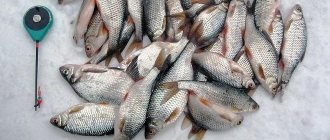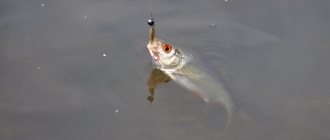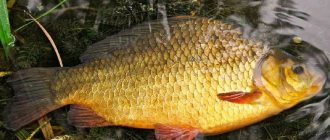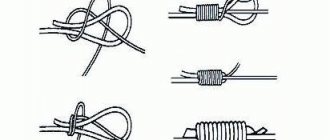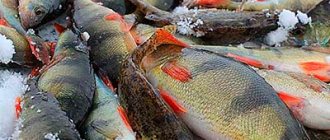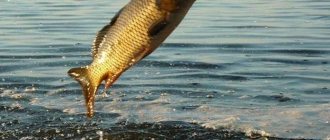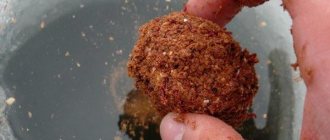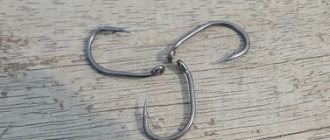Being an absolutely omnivorous creature, the carp constantly “prowls” in search of food, “sweeping away” any small and large “products” on its way: from all kinds of microscopic creations to relatively large snails, the hard shell of which it successfully crushes with its pharyngeal teeth. Carp does not disdain anything: neither algae leaves, nor insects (as well as their larvae), nor small mollusks or crustaceans.
But this is far from the complete range of its wide “menu”. Next come fry and tadpoles, caterpillars and slugs, eggs and even small dead fish. The carp's olfactory organs - the nostrils, located directly above the mouth - are quite good at capturing all these “smells” from a distance. Their skin valves, virtually continuously, direct water flows in and out.
"Food" routes of carp
In their natural habitat, on the water surface, carp likes to feed on peas, corn grains or other grains blown by the wind from agricultural fields, floating plants, and larvae (accidentally falling into the water from the shore and carried by the current to the middle of the reservoir). Descending deeper, he looks for daphnia and tadpoles. At the deepest bottom, diligently digging in the mud, it feeds on “heavy” snails and moths or other tasty things. At the same time, the carp swallows the sludge itself, along with fungi and bacteria that are beneficial to its body.
It is important for us, carp anglers, to know that carp with great pleasure greedily absorb food at virtually all levels of the water column (from the very surface to the deep bottom). That is why, in order to increase the number of bites, you need to adjust your equipment to its “level of feeding behavior”. The digestive tract of this fish was created by nature in such a way that it was possible to eat everything (naturally, edible and “smelly”). Rest assured, if a carp “smells” or sees something that can fit in its mouth, it will definitely taste the “new product”.
About the digestive process of carp
The carp's digestive process itself begins right in the mouth, where food is carefully crushed by the pharyngeal teeth. Additionally, behind the gill covers, the carp has small cavities with which it also “catches” food. Next, directly in the oral cavity, the fish secretes mucus and mixes with “products”, after which it moves straight through the esophagus into the “stomach” (as it is easier for us to conventionally call this organ). Thanks to the work of the esophageal muscles, all the water is squeezed out of food.
The intestinal tract of carp, figuratively speaking, is a rather long “pipe”, where swallowed food is gradually dissolved and processed with the help of special enzymes. Thus, protein fats are synthesized into glycerol and fatty acids, carbohydrates into sugar, and protein is decomposed into amino acids useful to the body.
All these vital elements (including minerals/vitamins) pass through the intestinal walls directly into the circulatory system. At the very end of the intestine there is a huge number of cells that produce mucus to envelop undigested food with a film, which then leaves the body. Interestingly, with the same color as when it was eaten.
It is definitely worth noting that carp (as well as other fish) is a cold-blooded creature, that is, its body temperature is approximately equal to the temperature of the water. Therefore, when the water warms, the metabolism of carp (as well as the absorption of food eaten) significantly accelerates; when the temperature drops, on the contrary, it slows down.
Important conclusions!
Based on the above, several valuable conclusions can be drawn. So, due to the lack of a stomach, finely divided food (i.e., consisting mainly of small particles) is more preferable for carp compared to large “food products”. This is how he eats in his natural environment. Therefore, if you feed carp large quantities of large fractions of food, then know that most of it will come out only partially digested.
This means that the bottom of the reservoir is gradually turning into a breeding ground for harmful bacteria that absorb oxygen and release nitrogen. According to scientists, this circumstance creates significant loads on the biological system of the reservoir, rapidly increasing the level of very harmful nitrates in it.
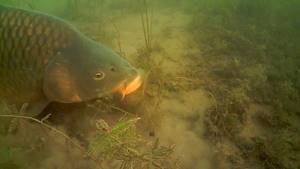
Use of flavoring for carp
But again, this division is rather arbitrary. Fishermen often follow not instructions, but their own experience and vision of the “correct” smell for carp or other fish. They use not only different aromas and their concentrations, but also make all kinds of mixtures from additives, combining aromas.
You need to understand that there is no “wonderful” or “super” carp flavoring or dip that will work always and everywhere. For the time of year, day, specific body of water and fish, you need to choose your “key” in the form of a scent. Therefore, the variety of odors among carp attractants is simply amazing. These smells are not always even pleasant for humans, and sometimes even exotic.
If an angler fishes in the same body of water and has chosen his working scent, then this will increase the effectiveness of bait and bait by about a quarter, but no more, and this does not always work. If the carp has fallen to the bottom and is on strike, then even the “stinkers” will not help.
Most often, amateur fishermen, after trial and error, select one, two or three scents or mixtures of scents and use it from spring to autumn. Moreover, the manufacturer is not as important here as professional fishermen “gurus” try to explain to us.
They all work for various companies and advertise their products. And today the choice of manufacturers is huge and you can choose a dip, attractant, etc. for a lower price. no worse (I don’t take into account the outright nameless “cheap”). You just have to try, and try to ignore advertising like: “Use only our “stinkers”, because they are the most attractive.”
Let's try to understand modern smells for carp fishing and give the main “folk” ones, i.e. “carp” aromas.
How do carp eat?
When eating (like people and animals), carp also actively use their senses. First, he may taste the food, then look at it again or “sniff” it before putting anything into his mouth. The carp's olfactory organs are simply well developed, which allows it to determine with maximum accuracy the value of substances dissolved in water. Despite the fact that the carp sees everything perfectly, but precisely at the moment when its future “meal” is located in front, it cannot see it, but can only “feel” it (for edibility) with the touch of its whiskers.
Sense organs of carp
Carp have an excellent sense of smell. In a matter of miles of a second, their brain is able to determine the edibility of future food. According to the results of numerous experiments, the most alluring “smells” for this fish are amino acids (characteristic of natural protein foods) and sucrose (characteristic of some plant foods).
Carp immediately classifies such products as having nutritional value for his body. Therefore, if the bait does not even have such particles/molecules on it, then the fish can simply bypass it. It is definitely worth noting that carp have a “memory” for negative moments in life. That is, some smells associated with being caught even a year ago can cause bad associations in him!
In addition to an excellent sense of smell, carp has an excellent sense of taste. Thanks to very sensitive cells (to chemical compounds), which cover virtually the entire internal cavity of the mouth, as well as other taste buds located on the whiskers, fins, along the sides of the body, and in the lower part of the head, carp determines the value of food with maximum accuracy.
When he notices a moth by the “smell”, then approaching the “point”, like a vacuum cleaner, swallows everything that gets in his way, including silt. Next, with the help of taste buds, he distinguishes bloodworms and holds them in his mouth, pushing them towards the pharyngeal teeth. Everything that is not edible (which is about 97%) immediately comes out through the gills (small particles) or is spat out through the mouth (large fractions).
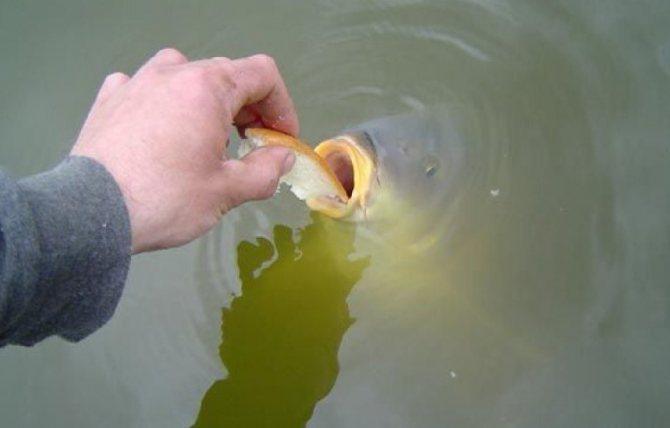
Carp delicacies
At the moment, there is a lot of debate on the topic of what is a delicacy for carp (i.e. the most delicious “dishes”). Most anglers believe that their favorite baits are boilies, breadcrumbs, baits with sweet/fruity or meaty odors, and stinky cheese.
Logically speaking, fish will always give preference to those aromas that are closer to nature, so boilies impregnated with natural attractors will naturally bring more success than any other bait. Including even imitation baits, but properly flavored. In addition, they have such an advantage as “durability” (small fish do not eat them, because silicone is “too tough”).
Carps not only sense all the smells and tastes of prey quite well, but also see perfectly. It is even worth noting that their eyes are much more sensitive than human eyes, especially in low light conditions. The vision of carp is designed in such a way as to see almost the entire surrounding area, 360 degrees, except for the “blind spot” in front of them (slightly below the mouth). That is why he is “shortsighted” and is forced to use his mustache “blindly” (which I talked about earlier).
Using different scents
Let's list what various flavoring additives can be used for.
Let's start with vanilla aroma. It has a very good reputation among fishermen. For the manufacture of. This smell in summer not only attracts carp, but is also pleasant for the fishermen themselves. It is used both for feeding fish and as bait. It should be noted that the matter is not limited to simply using vanilla. Recently, mixed flavors for carp based on it have gained popularity:
- pineapple with vanilla,
- strawberry and vanilla,
- vanilla with honey, as well as other similar mixtures.
Such options have become very common, and in cases where a large number of fishermen gather in one small area and simultaneously use these types of attractors, their effectiveness can be significantly reduced.
We would like to separately mention a group of fruit aromas (for example, peach, pineapple, banana, plum, strawberry and their combinations). Experimenting with different mixture options. You can try to find your own special version of your favorite smells for carp.
An important additive is honey. It is effective almost throughout the year. As in other cases, this scent can be used in various combinations.
The smell of caramel is not as popular, but can still be very effective in some cases. To create the aroma of hemp, both extract and just seeds are used. Garlic can be a good addition to attract carp.
In cold times, for example, in autumn, in September, it may turn out that your favorite smells are of a slightly different kind. We are talking about shrimp, shells or crabs with the addition of garlic or hemp.
Solutions can be the most unusual. For example, there is a bite activator, which, among other things, uses the smell of mud.
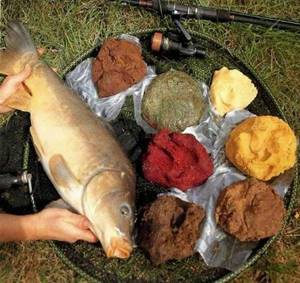
Reflections on modern baits
As of today, fishing stores offer a huge assortment of a wide variety of baits (as they say, for all occasions). But I propose to start a detailed analysis with their most popular variety - boilies.
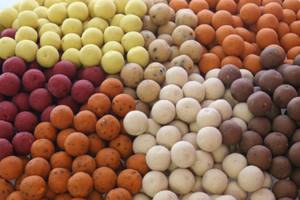
Boilies - advantages and disadvantages
Modern manufacturers have learned to produce boilies of any size, with a variety of tastes and smells. In fact, some are cooler than others. We just have to choose the most suitable option.
However, it should be remembered that one of the most important conditions for successful fishing is not the best equipment in the world, but faith in yourself (in your skills, in your fishing tactics). If this is not the case, you will quickly give up (sometimes even before the first bite). And even super catchy bait won’t help!
From a beginner's point of view, the main disadvantage of boilies is the fact that they often need to be attached to a hair rig. Of course, for experienced carp anglers with experience this is nonsense, but for beginners this event can cause a significant headache. I agree that at first, this is a difficult matter (in fact, it’s a whole science), but if you want to catch at least one record carp in your life, you need to study!
Why do most carp anglers prefer boilies? I believe that there are several main reasons: they have already been tested in practice for years (they have shown themselves to work well in practice), they are easier to store at home and are very easy to use when fishing.
About the varieties of boilies
Let's dig deeper and figure it out: what types of boilies do we know? So, in addition to the above-mentioned sizes and smells, they are also conventionally divided into ready-made / “commercial” boilies (with a long shelf life), frozen and “homemade” (i.e., made with your own hands).
Ready-made / “commercial” boilies can be purchased in virtually any fishing store. Being “sealed” in special packaging, they can be stored for months. And even when opened, they will not deteriorate for a long time (provided they are stored correctly: in a dry and cool place).
However, they begin to harden and lose valuable odors. If you leave them in the sun at all, they will quickly turn into crackers. If you “forget” in the rain, they will become moldy and stink. Try to always use fully opened packaging. But if there is anything left, there is no need to throw away the “balls”; freeze them in the refrigerator immediately upon arriving home.
frozen boilies can also be bought in any stores that have freezers. If possible, try to calculate their exact quantity, that is, buy exactly as much as you can use on one fishing trip.
And don't even try to refreeze them in the refrigerator! They will not only lose their smells and tastes, but also become harmful to the carp’s body!
“Home” boilies require special equipment, a lot of time and proper knowledge. However, catching fish using homemade/homemade boilies significantly increases self-esteem and can provide a lot of pleasure (incomparable to those when you use purchased/“store-bought” bait).
There are other advantages: firstly, you will always have super fresh boilies, and secondly, you can always adjust their recipe to strictly defined conditions (for example, for a specific reservoir).
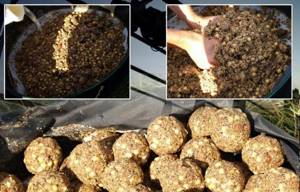
Mixture requirements
For successful fishing, you need to choose the right food, taking into account various factors. The main ones are the characteristics of the reservoir, the time of year, the preferences of the local underwater inhabitants and the weather. The mixture must be balanced and have certain working properties.
Any carp bait includes:
- basic components;
- binders and disintegrants;
- flavorings;
- bite activators;
- animal supplements.
An experienced fisherman skillfully combines ingredients, obtaining working and effective compositions.
Basic components
The following can be used as a feed base:
- porridge or cereals;
- grains;
- pellets;
- dry mixes;
- boilies.
A combination of these ingredients is often used. Many homemade baits contain grains of wheat, barley, millet, and crushed sunflower seeds. Carp also loves corn, so its use in different forms is justified.
Binders and disintegrants
In order for complementary food to have the correct consistency, not break when hitting water and begin to disintegrate at the bottom, forming an attractive spot, it is necessary to add binding and loosening components to it. Without them, it is impossible to obtain a high-quality working mixture.
Leavening agents include bread crumbs, bran, cake and milk powder. Breading, as a rule, is added to all bait mixtures. Falling to the bottom, the ball of food begins to “dust”, creating a cloud of turbidity, which can attract carp from a long distance.
Tip: Bread crumbs or bone and krill meal are also used as a leavening agent.
Of the binding components, “Hercules” is often used. Its amount in the mixture depends on the fishing conditions - the presence and strength of the current, depth, relief. The deeper at the fishing point and the more powerful the water flow, the more oatmeal should be added to the bait.
Recommended reading: How to properly catch pike with mugs
Aromatic additives depending on water temperature
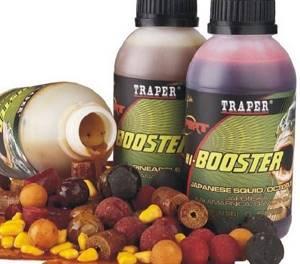
Bait for carp fishing should contain aromatics, which increases its effectiveness and range of action. In warm water, sweet and fruity smells are relevant - raspberry, vanilla, honey, cinnamon. In early spring, late autumn and winter, garlic, anise, dill, and animal protein are used.
Bite activators
This component allows you to significantly increase the number of fish bites. Recently, carp fishermen have been adding various factory-made attractants with pheromones to their complementary food, which can stimulate the activity of carp, even during hours of complete non-biting.
Animal supplements
From living components, small bloodworms are sometimes used, less often maggots or chopped worms. They must be added in small portions, otherwise the fish will quickly become saturated, which will lead to the cessation of biting. During the cold period, it is advisable to increase their number.
Note! Maggots swarming around in the middle of a common pile of food greatly irritates the fish, although it is precisely this that the carp may not eat.
Other types of bait
Carp can be successfully caught not only with boilies. There are many other equally successful baits, which can also be divided into several categories: “man food”, pellets, grains, floating and dough/shapes.
"Human Food"
Simply put, these are baits that are more suitable for human consumption than strictly for fish nutrition. These include: the most common bread, sausages/sausages, cheese, meat products, etc. That is, almost everything that you can buy in a supermarket for yourself. Bread is a universal bait that has been proven effective for hundreds of years.
It can be soaked to a dough-like state and rolled into a ball, after which it can be soaked in some flavored liquids. Or you can simply hook a bread crust onto a hook with your hair and let it float freely on the surface of the water, luring carp.
As for cheeses, these are my favorite baits, and any variety of them that can be attached to a hook in the form of squares or a dough-like mass. Ham is considered very popular in our country. Some anglers have had success fishing both for the highly cholesterol-laden pork and the anti-cholesterol curry.
Pellets
They are produced today in a huge assortment, with a wide variety of smells and tastes (from time-tested ones - trout, to special ones - carp).
Dough
Most fishing companies manufacture it today for use as an additional part to some types of boilies. The most important / unique property of the dough is the fastest possible transfer of flavor aromas in water. In addition, the boilies themselves, covered with dough, look a little “decomposed”, that is, much safer (from the “point of view” of the carp) than even glossy and beautiful (from our point of view) “rounds”. This kind of bait is capable of fooling even the most seasoned carp on a pond - a wise, long-lived native.

Assortment of grain crops
Grain mixtures can “serve” a lot of baits. The most famous of them, and the most popular, is hemp. Its oily composition literally attracts carp, even from afar, forcing them to “dig with their nose” square meters of silt in search of at least a couple more grains. That is why, if your bait is among several hemp seeds, the chances of catching carp increase significantly.
Due to the fact that they are too small (to be used on a hook “alone”), companies have long begun to produce hemp pellets on the hair (playing the role of a fail-safe attractor). Which, in combination with grain crops, create amazing baits / virtually irresistible to carp.
Grain baits can also include any cereal grains (corn, peas, beans, hummus or others), as well as the all-time favorite - tiger nut, and even food for pigeons and parrots. However, remember that all legumes or nuts must be soaked and properly cooked before fishing (to avoid harm to the health of the carp).
If you don’t know how to do it yourself, then it’s better to ask the specialists (!) several times. Before going fishing, be sure to ask: are your baits allowed on the body of water where you are going or are they prohibited? Some paid ponds have entire lists of prohibited grains.
Floating baits
As you can already guess from the name itself, this is everything edible that floats on the surface of the water. From bread crust and boilies to cat or dog food.
Don't be afraid to experiment! Before my eyes, a fairly large carp was caught right on a floating candy (regular chocolate with biscuit filling).
And finally, I would like to emphasize once again that it is important to constantly conduct experiments. There is no need to come fishing with “copied” tactics. After all, those people whom you are trying to imitate may be wrong. Therefore, both they and you may simply end up with an empty landing net. Don’t forget to check the fishing rules on the lakes where you plan to fish. And, of course, don’t forget to enjoy all the fun of carp fishing!
Translation of an interview with Ian Jameson for the Smart Carping club
More articles from Ian Jameson
- Alternative baits - search for non-standard solutions
- Bottom exploration with a marker rod
- Rocket feeding technique
- Tips for beginners: how to properly handle caught carp?
Related materials:
- Do-it-yourself boilies for carp fishing
- About the taste of carp and its favorite baits (author: Simon Scott)
- How to improve the solubility of baits? (by Tim Richardson)
Publication author
offline for 3 months
How to make bait for carp at home
Each fisherman has his own treasured feeding recipes. They differ in composition and working qualities, but the basic rules for preparing bait remain the same:
- The basis of any bait is cereal ingredients or cereals. Carp also loves peas, corn, and oats.
- Fine components should be used in mixtures. They create dust in the water and do not allow the fish to get enough.
- Carp loves aromatic food, so the use of flavorings and attractants is mandatory.
- You should add components similar to the bait used in the feed.
All ingredients must be fresh. They are prepared in the evening and mixed in the morning at the pond.
Recipe for the feeder
The simplest recipe:
- Soak peas and pearl barley in a 2:1 ratio in water for several hours. Then boil them over medium heat.
- Cook millet and corn porridge in a 1:1 ratio in another pan.
- We pre-soak a kilogram of wheat for 12 hours, and then also cook it in a separate bowl.
- Mix all the cooked cereals in one container.
Arriving at the pond, add flavorings and breadcrumbs. You can use pellets or a store-bought mixture.
Complementary foods for different seasons
Depending on the time of year, the composition of carp bait changes. The preferences of fish are influenced by weather, water temperature, and food supply. These factors must be taken into account when preparing for your upcoming fishing trip. Experienced carp fishermen use different food recipes.
For spring
The task of spring bait comes down to awakening the appetite of passive fish, forcing it to approach the feeding point and take the bait. A mixture of available ingredients works well:
- In a 1:1 ratio, pour peas, corn porridge, wheat and millet into a saucepan with boiling water.
- Cook until done, stirring constantly.
- At the end of cooking, add 150–200 grams of sugar to the resulting porridge, cover with a lid and leave to cool.
- At the pond, add some aromatic black bread and garlic to the mixture.
- We use cake or semolina as a leavening agent.
Recommended reading: Tackle for carp with makukha
Since in spring carp needs an increased amount of protein, we add bloodworms or finely chopped worms to the bait.
For summer
In summer, carp often go to shallow water, stay in the upper horizon, and prefer sweet smells. Here is a well-proven mixture recipe that even a novice angler can implement:
- Mix egg powder, soy flour and milk powder in a ratio of 1:2:3.
- Add breadcrumbs to the mixture.
- We use sugar and honey and a little cinnamon as flavorings and sweeteners.
We finally prepare the bait on the shore.
For autumn
In autumn, the requirements for carp bait are similar to those in spring. Carp needs an increased amount of protein, is often passive, feeds on exits, stays at medium and great depths, and moves little. A good recipe that experienced anglers like:
- Pour boiling water over the pearl barley and let it brew for about two hours.
- Mix bran, raisins, chopped peanuts, honey and also pour boiling water for half an hour.
- At the pond, add a pinch of bloodworms or chopped worms to the complementary food.
It is advisable to add a little soil to the mixture. We take water directly from the reservoir.
For winter
In winter, carp bait should not be greasy. It is based on animal components and soil. The simplest way to prepare the mixture:
- Mix the soil with bloodworms and chopped worms.
- Add breadcrumbs or milk powder.
- It is useful to add hemp, flax or poppy seeds.
In winter, you should not get carried away with attractants, so as not to scare the fish away from the fishing zone.

